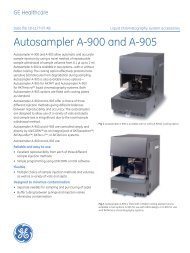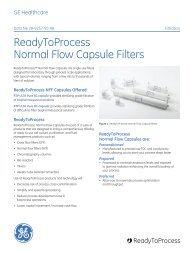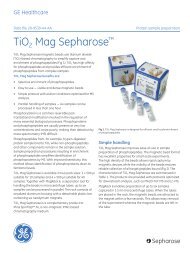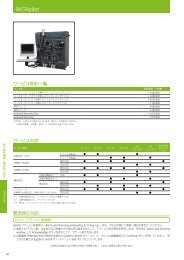HiTrap HIC Selection Kit - GE Healthcare Life Sciences
HiTrap HIC Selection Kit - GE Healthcare Life Sciences
HiTrap HIC Selection Kit - GE Healthcare Life Sciences
Create successful ePaper yourself
Turn your PDF publications into a flip-book with our unique Google optimized e-Paper software.
<strong>GE</strong> <strong>Healthcare</strong><br />
Data File 18-1143-21 AC<br />
Hydrophobic interaction chromatography<br />
<strong>HiTrap</strong> <strong>HIC</strong> <strong>Selection</strong> <strong>Kit</strong><br />
Introduction<br />
The <strong>HiTrap</strong> <strong>HIC</strong> <strong>Selection</strong> <strong>Kit</strong> consists of seven hydrophobic<br />
interaction chromatography (<strong>HIC</strong>) media with different<br />
hydrophobic characteristics. The kit provides you with the<br />
possibility to screen for the most appropriate <strong>HIC</strong> media to<br />
use for specific application and development work. The seven<br />
different <strong>HIC</strong> media are prepacked in ready to use 1 ml <strong>HiTrap</strong><br />
columns. Separations are easily performed with a syringe, a<br />
pump or a chromatography system such as ÄKTAdesign.<br />
• Convenient and fast to use<br />
• Simple operation<br />
• Hydrophobic interaction media screening<br />
• Easy to scale-up<br />
Hydrophobic interaction<br />
chromatography<br />
Substances are separated on the basis of their varying<br />
strengths of hydrophobic interactions with hydrophobic<br />
groups attached to an uncharged matrix. This technique<br />
is usually performed in the presence of moderately high<br />
concentrations of salts in the adsorption buffer (these salts<br />
promote adsorption and may have a stabilizing influence<br />
on protein structure). Elution is achieved by a linear or<br />
stepwise decrease in concentration of the salt. Several<br />
factors influence the chromatographic behavior of proteins<br />
and peptides on hydrophobic adsorbents. Parameters<br />
that influence binding, resolution, selectivity, and recovery<br />
include:<br />
• Ligand structure and ligand density<br />
• Type of base matrix<br />
• Sample characteristics<br />
• Flow rate<br />
• Type and concentration of salt<br />
• Temperature<br />
Fig 1. <strong>HiTrap</strong> <strong>HIC</strong> <strong>Selection</strong> <strong>Kit</strong> now including seven different<br />
<strong>HiTrap</strong> <strong>HIC</strong> 1-ml columns.<br />
The practical implication of these effects is that different<br />
<strong>HIC</strong> media must be compared individually. The choice<br />
of ligand, type, and concentration of salt and pH are<br />
all empirical and must be established by screening<br />
experiments for each separation.<br />
Media characteristics<br />
The <strong>HIC</strong> media packed in the <strong>HiTrap</strong> columns are based<br />
on the highly cross-linked beaded agarose matrices,<br />
Sepharose Fast Flow, and Sepharose High Performance,<br />
which have excellent flow properties and high physical<br />
and chemical stability. The <strong>HIC</strong> ligands are coupled to<br />
the monosacharide units via their corresponding glycidyl<br />
ethers, giving matrices without charges and stable ether<br />
bonds between the ligands and the agarose. The ligands<br />
are shown in Table 1.<br />
imagination at work
Table 1. Characteristics of <strong>HiTrap</strong> <strong>HIC</strong> media<br />
Ligand density Average particle pH stability pH stability<br />
Media 1 Hydrophobic ligand (µmol/ml medium) size (µm) Short term 2 Long term 3<br />
Phenyl Sepharose Phenyl —O—<br />
High Performance 25 34 2–14 3–13<br />
Phenyl Sepharose Phenyl —O—<br />
6 Fast Flow (low sub) 25 90 2–14 3–13<br />
Phenyl Sepharose Phenyl —O—<br />
6 Fast Flow (high sub) 40 90 2–14 3–13<br />
Butyl Sepharose Butyl —O—(CH<br />
High Performance<br />
2<br />
) 3<br />
—CH 3<br />
50 34 2–14 3–13<br />
Butyl Sepharose Butyl —O—(CH<br />
4 Fast Flow 4 2<br />
) 3<br />
—CH 3<br />
40 90 2–14 3–13<br />
Butyl-S Sepharose Butyl-S —S—(CH 2<br />
) 3<br />
—CH 3<br />
6 Fast Flow 10 90 2–14 3–13<br />
Octyl Sepharose<br />
4 Fast Flow 4 5 90 2–14 3–13<br />
Octyl —O—(CH 2<br />
) 7<br />
—CH 3<br />
Table 3. Characteristics of <strong>HiTrap</strong> 1-ml column<br />
1<br />
Storage: 0.01 M NaOH or 20% ethanol.<br />
2<br />
pH stability, short term: pH interval to which the medium can be subjected for cleaning- or sanitization-in-place (accumulated 90-100 hours at room temperature) without significant change in function.<br />
3<br />
pH stability, long term: pH interval where the medium can be operated without significant change in function.<br />
4<br />
Matrices: All media are based on spherical, 6% cross-linked agarose beads except for Butyl Sepharose 4 Fast Flow and Octyl Sepharose 4 Fast Flow, which are based on spherical,<br />
4% cross-linked agarose beads.<br />
Table 2. Chemical stability of <strong>HIC</strong> media.<br />
Phenyl Phenyl Phenyl Butyl<br />
Sepharose Sepharose 6 Sepharose 6 Sepharose Butyl Butyl-S Octyl<br />
High Fast Flow Fast Flow High Sepharose 4 Sepharose 6 Sepharose 4<br />
Performance (low sub) (high sub) Performance Fast Flow Fast Flow Fast Flow<br />
1 M NaOH X X X X X X X<br />
1 M acetic acid X n.d. n.d. X n.d. n.d. n.d.<br />
1 mM HCl n.d. n.d. n.d. X X X X<br />
3 M (NH 4<br />
)SO 4<br />
n.d. X X X n.d. X n.d.<br />
70% ethanol X X X X X X X<br />
30% isopropanol X X X X X X X<br />
6 M guanidine<br />
hydrochloride X X X X X X X<br />
8 M urea X X X X n.d. X n.d.<br />
X<br />
= functionally stable for 7 days at 40°C.<br />
n.d. = not determinded<br />
<strong>HiTrap</strong> <strong>HIC</strong> <strong>Selection</strong> <strong>Kit</strong> consists of the following seven<br />
prepacked <strong>HIC</strong> media from <strong>GE</strong> <strong>Healthcare</strong>. Each has<br />
different hydrophobic characteristics.<br />
• Phenyl Sepharose High Performance<br />
• Phenyl Sepharose 6 Fast Flow (low sub)<br />
• Phenyl Sepharose 6 Fast Flow (high sub)<br />
• Butyl Sepharose High Performance<br />
• Butyl Sepharose 4 Fast Flow<br />
• Butyl-S Sepharose 6 Fast Flow<br />
• Octyl Sepharose 4 Fast Flow<br />
Characteristics of <strong>HiTrap</strong> <strong>HIC</strong> media are listed in Table 1 and<br />
their chemical stability is shown in Table 2.<br />
Column characteristics<br />
The characteristics of <strong>HiTrap</strong> columns are shown in Table 3.<br />
The columns are made of bio-inert polypropylene. The<br />
column is delivered with a stopper on the inlet and a snapoff<br />
end on the outlet. Connectors for using the columns with<br />
a syringe, laboratory pump, or a chromatography system<br />
are included in the package. Note that <strong>HiTrap</strong> columns<br />
cannot be opened or refilled.<br />
Recommended flow rate<br />
Maximum flow rate<br />
Column dimensions<br />
Column volume<br />
Maximum backpressure<br />
1.0 ml/min<br />
4.0 ml/min<br />
0.7 × 2.5 cm<br />
1 ml<br />
3 bar, 42 psi, 0.3 MPa<br />
<br />
Data File 18-1143-21 AC
Sample: Cytochrome C, Ribonuclease A, Lysozyme,α<br />
a-chymotrypsinogen 6 mg protein/ml, (1:3:1:1) in start buffer<br />
Column volume: 1 ml<br />
Sample volume: 1 ml<br />
Sample load: 6 mg protein/ml medium<br />
Flow rate: 1.0 ml/min, (150 cm/h)<br />
Start buffer (A): 0.1 M Na 2<br />
HPO 4<br />
, 1.7 M (NH 4<br />
) 2<br />
SO 4<br />
, pH 7.0<br />
Elution buffer (B): 0.1 M Na 2<br />
HPO 4<br />
, pH 7.0<br />
Gradient: 0%–100% Elution buffer in 10 ml<br />
System: ÄKTAfplc<br />
Phenyl Sepharose High Performance Phenyl Sepharose 6 Fast Flow (low sub) Phenyl Sepharose 6 Fast Flow (high sub)<br />
mAU<br />
800<br />
600<br />
400<br />
200<br />
2.33<br />
14.84<br />
18.27<br />
20.42<br />
0<br />
0<br />
0.0 5.0 10.0 15.0 20.0 25.0 ml<br />
mS/cm<br />
200<br />
150<br />
100<br />
50<br />
mAU<br />
800<br />
600<br />
400<br />
200<br />
2.13 18.52<br />
0<br />
0<br />
0.0 5.0 10.0 15.0 20.0 25.0 ml<br />
mS/cm<br />
200<br />
150<br />
100<br />
50<br />
mAU<br />
800<br />
600<br />
400<br />
200<br />
2.54<br />
16.43<br />
21.21<br />
0<br />
0<br />
0.0 5.0 10.0 15.0 20.0 25.0 ml<br />
mS/cm<br />
200<br />
150<br />
100<br />
50<br />
Butyl-S Sepharose 6 Fast Flow<br />
mAU<br />
mS/cm<br />
200<br />
Butyl Sepharose 4 Fast Flow<br />
mAU<br />
mS/cm<br />
200<br />
Octyl Sepharose 4 Fast Flow<br />
mAU<br />
mS/cm<br />
200<br />
800<br />
800<br />
800<br />
600<br />
400<br />
1.97 16.61<br />
150<br />
100<br />
600<br />
400<br />
2.05<br />
17.40<br />
19.29<br />
150<br />
100<br />
600<br />
400<br />
2.11<br />
17.48<br />
150<br />
100<br />
200<br />
50<br />
200<br />
50<br />
200<br />
50<br />
0<br />
0.0 5.0 10.0 15.0 20.0 25.0 ml<br />
0<br />
14.77<br />
0<br />
0.0 5.0 10.0 15.0 20.0 25.0 ml<br />
0<br />
0<br />
0.0 5.0 10.0 15.0 20.0 25.0 ml<br />
0<br />
Butyl Sepharose High Performance<br />
mAU<br />
800<br />
600<br />
2.37<br />
18.02<br />
20.39<br />
mS/cm<br />
200<br />
150<br />
100<br />
400<br />
200<br />
15.23<br />
50<br />
0<br />
0<br />
0.0 5.0 10.0 15.0 20.0 25.0 ml<br />
Fig 2. Comparison of the selectivity of the<br />
different media in <strong>HiTrap</strong> <strong>HIC</strong> <strong>Selection</strong> <strong>Kit</strong>.<br />
Elution volumes at each peak.<br />
Operation<br />
Complete, easy-to-follow instructions are included for fast<br />
startup, media, and method optimization. Separations can<br />
be easily achieved using a syringe for stepwise elution,<br />
or a pump or a liquid chromatography system such as<br />
ÄKTAdesign for gradient applications. A set of connectors is<br />
supplied for connection of the column to different types of<br />
equipment.<br />
For quick scale-up of purifications, two or three <strong>HiTrap</strong><br />
<strong>HIC</strong> columns of the same type can be connected in series.<br />
Further scale-up can be achieved using the prepacked<br />
columns HiPrep 16/10 Phenyl FF (high sub), HiPrep 16/10<br />
Phenyl FF (low sub), HiPrep 16/10 Butyl FF, or HiPrep 16/10<br />
Octyl FF. Prepacked HiLoad Phenyl Sepharose HP or bulk<br />
media packs are also available, see ordering information.<br />
Regeneration of <strong>HIC</strong> adsorbents is normally done by<br />
washing with distilled water. To prevent slow build up of<br />
contaminants on the column over time, regular cleaning is<br />
advised. Precipitated proteins can be removed by washing<br />
with 0.5–1.0 M NaOH followed by distilled water. Strongly<br />
bound substances can be removed by washing with up to<br />
70% ethanol or 30% isopropanol.<br />
For longer periods of storage, the columns should be filled with<br />
20% ethanol or 0.01 M NaOH and stored at 4°C to 30°C.<br />
Applications<br />
Screening<br />
The effects of the different hydrophobic characteristics of<br />
the seven <strong>HIC</strong> media are shown in Figure 2. Model proteins<br />
were separated using the same method and buffers. After<br />
sample injection and washing, the bound proteins were<br />
eluted with a decreasing gradient over 10 ml.<br />
Another example is shown in Figure 3, where Ribonuclease<br />
A and ββ-lactoglobulin were separated on the seven<br />
<strong>HIC</strong> media using the same method. The different media<br />
were ranked according to increasing elution volume for<br />
Ribonuclease A. As can be seen, the ranking is completely<br />
different for β-lactoglobulin, indicating differences in<br />
selectivity, the largest differences are demonstrated for<br />
Octyl Sepharose 4 Fast Flow and Butyl-S Sepharose 6 Fast Flow.<br />
Data File 18-1143-21 AC
Elution vol. (ml)<br />
25<br />
20<br />
15<br />
10<br />
5<br />
0<br />
Butyl-S Sepharose FF<br />
Sample:<br />
Cytochrome C, Ribonuclease A, Lysozyme,<br />
αa-chymotrypsinogen 6 mg protein/ml,<br />
(1:3:1:1) in start buffer<br />
Column volume: 1 ml<br />
Sample volume: 1 ml<br />
Flow rate:<br />
0.5 ml/min, (75 cm/h)<br />
Start buffer (A): 0.1 M Na 2<br />
HPO 4<br />
,<br />
Containing in A 1.7 M (NH 4<br />
) 2<br />
SO 4<br />
, pH 7.0<br />
Containing in B 1.0 M Na 2<br />
SO 4<br />
, pH 7.0<br />
Containing in C 3.0 M NaCl, pH 7.0<br />
Elution buffer (B): 0.1 M Na 2<br />
HPO 4<br />
, pH 7.0<br />
Gradient:<br />
Detection:<br />
0%–100% Elution buffer in 10 ml<br />
UV-M, 5 mm cell,<br />
280 nm, 1.0 AUFS<br />
A. 1.7 M (NH 4<br />
) 2<br />
SO 4<br />
B. 1.0 M Na 2<br />
SO 4<br />
C. 3.0 M NaCl<br />
A 280nm<br />
0.5<br />
0.4<br />
0.3<br />
0.2<br />
0.1<br />
5 10 15 20<br />
Volume (ml)<br />
Ribonuclease A<br />
ß-lactoglobulin<br />
Octyl Sepharose FF<br />
Phenyl Sepharose FF (low sub)<br />
Butyl Sepharose FF<br />
Phenyl Sepharose HP<br />
A 280nm<br />
0.5<br />
0.4<br />
0.3<br />
0.2<br />
0.1<br />
5 10 15 20<br />
Volume (ml)<br />
Butyl Sepharose HP<br />
Phenyl Sepharose FF (high sub)<br />
Fig 3. Comparison of elution volume for Ribonuclease A and β-lactoglobulin.<br />
The different <strong>HIC</strong> media are arranged after increasing elution<br />
volumes for Ribonuclease A.<br />
A 280nm<br />
0.5<br />
0.4<br />
0.3<br />
0.2<br />
0.1<br />
5 10 15 20<br />
Volume (ml)<br />
Effect of different salts<br />
The most frequently used salts in <strong>HIC</strong> are ammonium<br />
sulfate and sodium sulfate. “Weaker” salts such as sodium<br />
chloride may also be considered. The effect of these salts<br />
on the separation is shown in Figure 4. The same sample<br />
was separated on Butyl Sepharose 4 Fast Flow with the<br />
different salts, ammonium sulfate, sodium sulfate and<br />
sodium chloride. The type of salt and its concentration<br />
have a profound effect on the chromatographic separation.<br />
Ordering information<br />
Product Quantity Code No.<br />
<strong>HiTrap</strong> <strong>HIC</strong> <strong>Selection</strong> <strong>Kit</strong>,<br />
seven different <strong>HIC</strong> media 7 × 1 ml 28-4110-07<br />
Related products Quantity Code No.<br />
Prepacked columns<br />
<strong>HiTrap</strong> Phenyl FF (high sub) 5 × 1 ml 17-1355-01<br />
<strong>HiTrap</strong> Phenyl FF (high sub) 5 × 5 ml 17-5193-01<br />
<strong>HiTrap</strong> Phenyl FF (low sub) 5 × 1 ml 17-1353-01<br />
<strong>HiTrap</strong> Phenyl FF (low sub) 5 × 5 ml 17-5194-01<br />
<strong>HiTrap</strong> Phenyl HP 5 × 1 ml 17-1351-01<br />
<strong>HiTrap</strong> Phenyl HP 5 × 5 ml 17-5195-01<br />
<strong>HiTrap</strong> Butyl HP 5 × 1 ml 28-4110-01<br />
<strong>HiTrap</strong> Butyl HP 5 × 5 ml 28-4110-05<br />
<strong>HiTrap</strong> Butyl FF 5 × 1 ml 17-1357-01<br />
<strong>HiTrap</strong> Butyl FF 5 × 5 ml 17-5197-01<br />
<strong>HiTrap</strong> Butyl-S FF 5 × 1 ml 17-0978-13<br />
<strong>HiTrap</strong> Butyl-S FF 5 × 5 ml 17-0978-14<br />
<strong>HiTrap</strong> Octyl FF 5 × 1 ml 17-1359-01<br />
<strong>HiTrap</strong> Octyl FF 5 × 5 ml 17-5196-01<br />
HiPrep 16/10 Phenyl FF<br />
(high sub) 1 (20 ml) 17-5095-01<br />
HiPrep 16/10 Phenyl FF<br />
(low sub) 1 (20 ml) 17-5094-01<br />
HiPrep 16/10 Butyl FF 1 (20 ml) 17-5096-01<br />
HiPrep 16/10 Octyl FF 1 (20 ml) 17-5097-01<br />
HiLoad 16/10 Phenyl<br />
Sepharose HP 1 (20 ml) 17-1085-01<br />
HiLoad 26/10 Phenyl<br />
Sepharose HP 1 (53 ml) 17-1086-01<br />
Fig 4 A–C. Effect of different salts on selectivity and resolution when the<br />
same sample was separated on Butyl Sepharose 4 Fast Flow.<br />
<br />
Data File 18-1143-21 AC
Bulk media Quantity Code No.<br />
Phenyl Sepharose<br />
High Performance 75 ml 1 17-1082-01<br />
Phenyl Sepharose 6 25 ml 17-0965-10<br />
Fast Flow (low sub) 200 ml 1 17-0965-05<br />
Phenyl Sepharose 6 25 ml 17-0973-10<br />
Fast Flow (high sub) 200 ml 1 17-0973-05<br />
Butyl Sepharose 25 ml 17-5432-01<br />
High Performance 200 ml 1 17-5432-02<br />
Butyl Sepharose 4 Fast Flow 25 ml 17-0980-10<br />
200 ml 1 17-0980-01<br />
Butyl-S Sepharose 6 Fast Flow 25 ml 17-0978-10<br />
200 ml 1 17-0978-02<br />
Octyl Sepharose 4 Fast Flow 25 ml 17-0946-10<br />
200 ml 1 17-0946-02<br />
1<br />
Larger quantities are available. Please contact <strong>GE</strong> <strong>Healthcare</strong> for more information.<br />
Accessories Quantity Code No.<br />
1/16” male/luer female 1 2 18-1112-51<br />
Tubing connector flangeless/<br />
M6 female 1 2 18-1003-68<br />
Tubing connector flangeless/<br />
M6 male 1 2 18-1017-98<br />
Union 1/16” female/M6 male 1 6 18-1112-57<br />
Union M6 female /1/16” male 1 5 18-3858-01<br />
Union luerlock female/M6 female 2 18-1027-12<br />
<strong>HiTrap</strong>/HiPrep, 1/16” male<br />
connector for ÄKTAdesign 8 28-4010-81<br />
Stop plug female, 1/16” 2 5 11-0004-64<br />
Fingertight stop plug, 1/16 ”3 5 11-0003-55<br />
1<br />
One connector included in each <strong>HiTrap</strong> package.<br />
2<br />
Two, five, or seven stop plugs female included in <strong>HiTrap</strong> packages depending on the product.<br />
3<br />
One fingertight stop plug is connected to the top of each <strong>HiTrap</strong> column at delivery.<br />
Literature<br />
Code No.<br />
Hydrophobic Interaction Chromatography &<br />
Reversed Phase Chromatography, Principles<br />
and Methods, Handbook 11-0012-69<br />
Convenient Protein Purification,<br />
<strong>HiTrap</strong> Column Guide 18-1129-81<br />
Please check www.gehealthcare.com/hitrap or contact your<br />
local representative for further information.<br />
Data File 18-1143-21 AC
www.gehealthcare.com/hitrap<br />
<strong>GE</strong> <strong>Healthcare</strong> Bio-<strong>Sciences</strong> AB<br />
Björkgatan 30<br />
751 84 Uppsala<br />
Sweden<br />
<strong>GE</strong>, imagination at work and <strong>GE</strong> Monogram are trademarks of General<br />
Electric Company.<br />
Sepharose, HiLoad, <strong>HiTrap</strong>, HiPrep, ÄKTAdesign and ÄKTAfplc, are<br />
trademarks of <strong>GE</strong> <strong>Healthcare</strong> companies.<br />
© 2000–2007 General Electric Company – All rights reserved.<br />
First published April 2000<br />
All goods and services are sold subject to the terms and conditions of<br />
sale of the company within <strong>GE</strong> <strong>Healthcare</strong> which supplies them. A copy of<br />
these terms and conditions is available on request. Contact your local <strong>GE</strong><br />
<strong>Healthcare</strong> representative for the most current information.<br />
<strong>GE</strong> <strong>Healthcare</strong> Europe GmbH<br />
Munzinger Strasse 5, D-79111 Freiburg, Germany<br />
<strong>GE</strong> <strong>Healthcare</strong> UK Ltd<br />
Amersham Place, Little Chalfont, Buckinghamshire, HP7 9NA, UK<br />
<strong>GE</strong> <strong>Healthcare</strong> Bio-<strong>Sciences</strong> Corp<br />
800 Centennial Avenue, P.O. Box 1327, Piscataway,<br />
NJ 08855-1327, USA<br />
<strong>GE</strong> <strong>Healthcare</strong> Bio-<strong>Sciences</strong> KK<br />
Sanken Bldg. 3-25-1, Hyakunincho, Shinjuku-ku,<br />
Tokyo 169-0073, Japan<br />
Asia Pacific T +85 65 62751830 F +85 65 62751829 • Australasia T +61 2 8820 8299 F +61 2 8820 8200 • Austria T 01 /57606 1613 F 01 /57606 1614 • Belgium T 0800 73 890 F 02 416 8206 • Canada T 1 800 463 5800 F 1 800 567 1008 • Central<br />
& East Europe T +43 1 972 720 F +43 1 972 722 750 • Denmark T +45 70 25 24 50 F +45 45 16 2424 • Eire T 1 800 709992 F +44 1494 542010 • Finland & Baltics T +358 9 512 3940 F +358 9 512 39439 • France T 01 69 35 67 00 F 01 69 41 98 77<br />
Germany T 0800 9080 711 F 0800 9080 712 • Greater China T +852 2100 6300 F +852 2100 6338 • Italy T 02 26001 320 F 02 26001 399 • Japan T 81 3 5331 9336 F 81 3 5331 9370 • Korea T 82 2 6201 3700 F 82 2 6201 3803 • Latin America T +55 11 3933 7300<br />
F +55 11 3933 7304 • Middle East & Africa T +30 210 96 00 687 F +30 210 96 00 693 • Netherlands T 0800-82 82 82 1 F 0800-82 82 82 4 • Norway T +47 815 65 777 F +47 815 65 666 • Portugal T 21 417 7035 F 21 417 3184 • Russia, CIS & NIS<br />
T +7 495 956 5177 F +7 495 956 5176 • Spain T 902 11 72 65 F 935 94 49 65 • Sweden T 018 612 1900 F 018 612 1910 • Switzerland T 0848 8028 10 F 0848 8028 11 • UK T 0800 515 313 F 0800 616 927 • USA T +1 800 526 3593 F +1 877 295 8102<br />
imagination at work<br />
18-1143-21 AC 01/2007


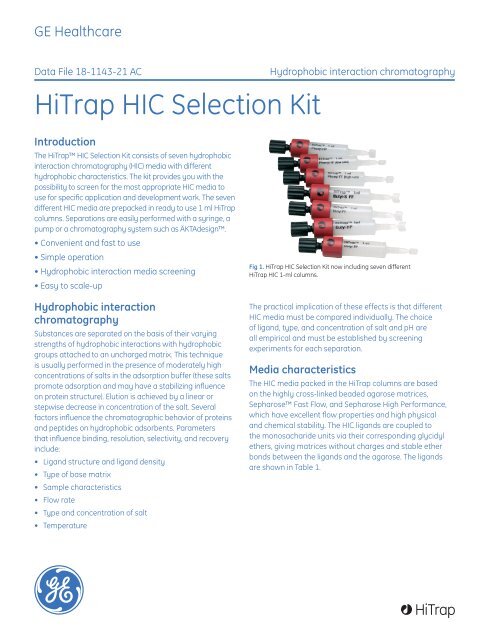
![[PDF] マニュアル GradiFrac](https://img.yumpu.com/22037825/1/190x253/pdf-gradifrac.jpg?quality=85)
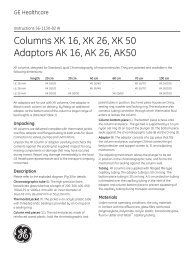
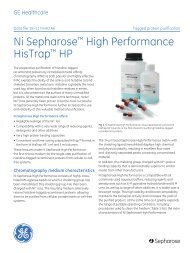
![[PDF] Sample preparation for analysis of protein, peptides and ...](https://img.yumpu.com/21549715/1/190x257/pdf-sample-preparation-for-analysis-of-protein-peptides-and-.jpg?quality=85)
![[PDF] Data File: rProtein A Sepharose Fast Flow](https://img.yumpu.com/21549316/1/190x253/pdf-data-file-rprotein-a-sepharose-fast-flow.jpg?quality=85)
![[PDF] MBP-tagged protein purification](https://img.yumpu.com/21548507/1/184x260/pdf-mbp-tagged-protein-purification.jpg?quality=85)
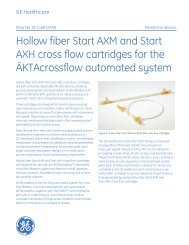
![[PDF] AKTA ready system Data file](https://img.yumpu.com/21540925/1/190x253/pdf-akta-ready-system-data-file.jpg?quality=85)
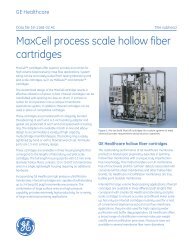
![[PDF] Data File - rProtein A/Protein G GraviTrap](https://img.yumpu.com/21539052/1/190x253/pdf-data-file-rprotein-a-protein-g-gravitrap.jpg?quality=85)
